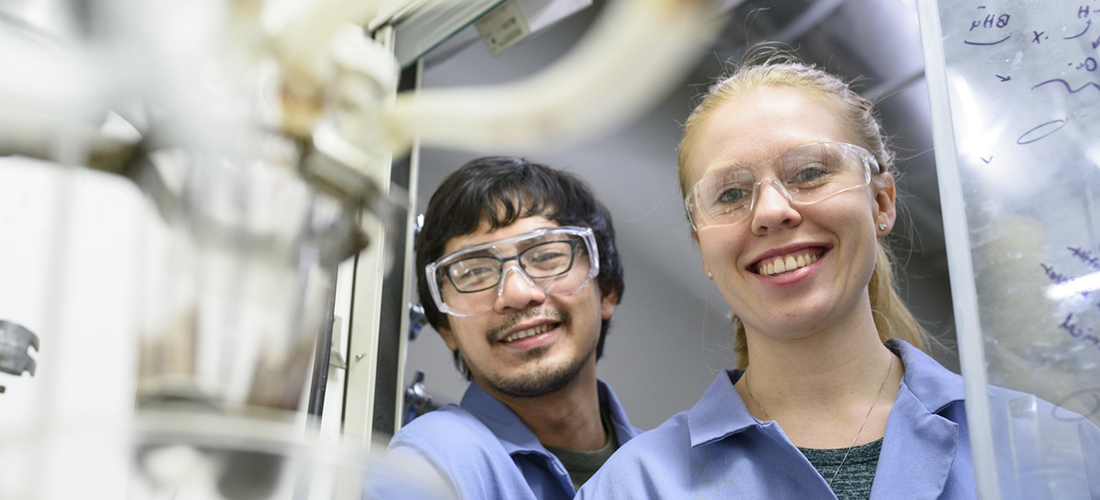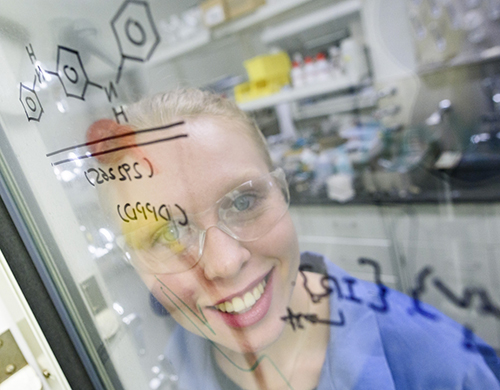
Christopher Robidillo (left) and Christina Braun (right) are among the first intake of students to the ATUMS program.
Graduate students at the University of Alberta are getting the opportunity of a lifetime, thanks to a new international graduate school with German partners: the Alberta/TUM International Graduate School for Hybrid Functional Materials (ATUMS).
Professor Jonathan Veinot (chemistry), the program's founder, notes that bringing everyone together from the various disciplines and cultures removes potential road blocks on the route to discovery and production.
"Everybody benefits both intellectually and professionally," he explains. "Our students are learning how to communicate across not only disciplines but also across cultures. The partnership with Munich has been very appealing for potential students," says Veinot. "The travel to Germany and the collaboration is something that really excites them."
One of the key strengths of the program is its emphasis on interdisciplinary scientific collaboration. "If you're an engineer and you want to make a new light-emitting diode, you're going to look at what's commercially available for the materials you use to make that device. If you're a chemist, you're going to make the materials but you won't necessarily be able to make the device. And if you're a physicist, you understand the behavior of the device, but you won't necessarily be able to make the materials or fabricate the device," Veinot explains. "With ATUMS, we have chemists talking to engineers talking to physicists about the ideal materials to make devices behave the way we want."
An opportunity "too good to pass up"
"ATUMS has a collaborative research appeal to it," says current student Christopher Robidillo. "The opportunity of working on interdisciplinary projects and learning from different supervisors at both the U of A and TUM offers a unique research environment that is just too good to pass up."
Robidillo, whose hometown is Manila, Philippines, is working on the preparation of advanced functional nanomaterials, preparing nanostructures with novel and useful properties. He says he was drawn to the program to work with Veinot, who is internationally renowned for his expertise in silicon nanocrystal chemistry and organic polymer semiconductors.
"The research and professional skills that I'll acquire from the ATUMS program will provide me a sure advantage in getting post-doc research opportunities," continues Robidillo, adding that he is excited about the doors that will be opened as a result of studying in this unique program and is most looking forward to traveling to and doing research in Germany in his third year.
Fellow ATUMS student, Christina Braun, echoes that sentiment. "When I visited the U of A as a potential graduate student, the final selling point was the ATUMS program, which allows for the possibility to do research in Germany for a few months. Germany is a beautiful country where a lot of hot chemistry is taking place." Like Robidillo, Braun was also taken with the U of A campus. "Everyone I met was so kind, and the research facilities are excellent."
 Braun-who is studying inorganic chemistry with a focus on compounds containing tellurium-is working with supervisor Eric Rivard (chemistry). "I was immediately intrigued by his enthusiasm and found his research to be very interesting," the London, Ontario native says of Rivard. "We are interested in making tellurium-containing polymers that may have applications in organic light emitting diode (or OLED) devices among other possibilities."
Braun-who is studying inorganic chemistry with a focus on compounds containing tellurium-is working with supervisor Eric Rivard (chemistry). "I was immediately intrigued by his enthusiasm and found his research to be very interesting," the London, Ontario native says of Rivard. "We are interested in making tellurium-containing polymers that may have applications in organic light emitting diode (or OLED) devices among other possibilities."
Looking forward to the future, Braun says she believes that establishing relationships with these German colleagues through the ATUMS program will set her apart and ultimately help in her job search.
ATUMS is also providing up to 10 hours of paid professional development each year for its students covering such topics as career counseling, mock interviews, presentation skills, self-promotion training, presentation skills, intellectual property policy, and social media training.
Veinot says that though the PD opportunities have been developed for ATUMS students, he wants to increase the impact by sharing these opportunities with U of A other students. "We want the programs in general to get stronger."
The ATUMS program was funded thanks to a $1.65M grant from the Natural Sciences and Engineering Research Council of Canada (NSERC) Collaborative Research and Training Experience (CREATE) program.
Students are encouraged to apply to their home department graduate program (i.e., Chemistry, Physics, Electrical and Computer Engineering) and indicate their interest in ATUMS. The February 1 deadline for application is flexible. For more details please contact the ATUMS Coordinator at Veinot@ualberta.ca.